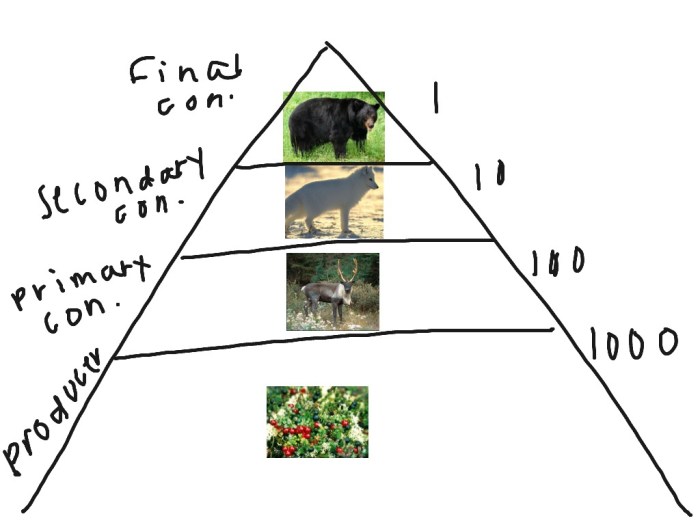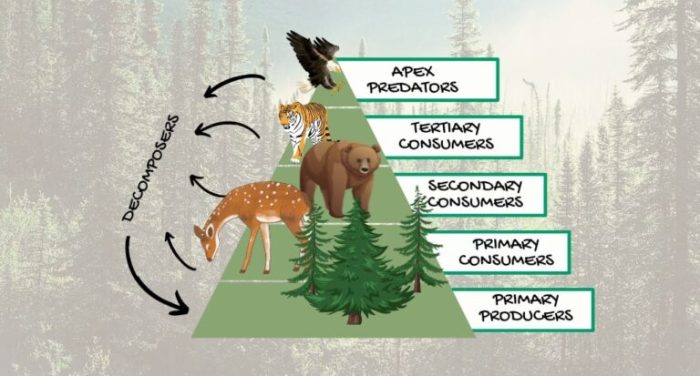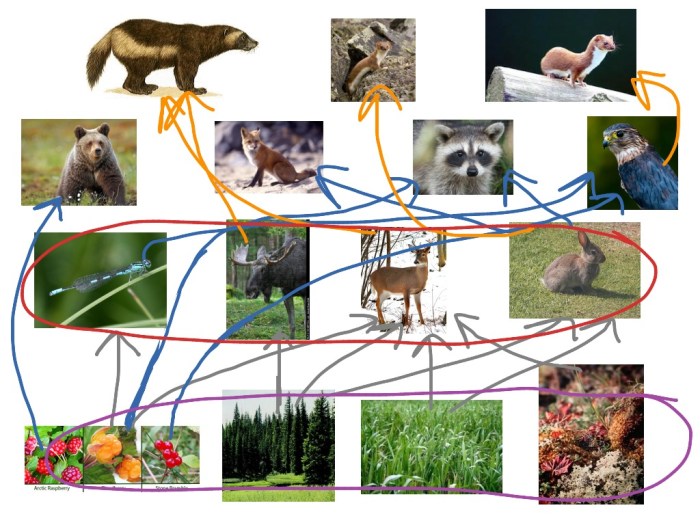Food chains in the taiga – Embark on a journey into the heart of the taiga, a vast and enigmatic ecosystem where food chains intertwine like intricate threads in a cosmic tapestry. From towering trees to elusive predators, the taiga teems with an astonishing array of life, each species playing a vital role in maintaining the delicate balance of this northern realm.
Delve into the intricacies of trophic levels, where energy flows like a river, cascading from primary producers to top predators. Discover the interdependence of species, where the survival of one hinges on the well-being of others. Witness the remarkable adaptations that enable organisms to thrive in the harsh seasonal cycles of the taiga.
Food Sources in the Taiga

The taiga, a vast and sprawling ecosystem, harbors a diverse array of life forms that depend on each other for sustenance. Understanding the food sources in this region is crucial to unraveling the intricate web of ecological interactions that sustain its inhabitants.
Primary Producers
The foundation of the taiga’s food chain lies in the realm of primary producers, organisms that harness the sun’s energy to create their own nourishment. The taiga’s primary producers are predominantly photosynthetic plants, including:
- Coniferous trees, such as spruce, fir, and pine, dominate the taiga landscape, their evergreen needles providing year-round sustenance.
- Deciduous trees, like birch and aspen, add a touch of seasonal color to the taiga, their leaves providing food and shelter for various species.
- Shrubs and groundcover, including willows, alders, and mosses, fill the understory, offering diverse habitats and food sources.
Decomposers
Decomposers, nature’s recyclers, play a vital role in nutrient cycling within the taiga. Fungi and bacteria break down dead plant and animal matter, releasing essential nutrients back into the ecosystem. These nutrients are then available for uptake by primary producers, completing the cycle of life and sustenance.
Food Sources for Herbivores
Herbivores, the primary consumers in the taiga, feed directly on plants. This diverse group includes:
- Mammals, such as moose, deer, and hares, roam the forests, grazing on vegetation and browsing on leaves.
- Birds, including crossbills and pine siskins, have specialized beaks and digestive systems that allow them to exploit conifer seeds.
- Insects, like caterpillars and beetles, feed on leaves, needles, and other plant tissues.
Food Sources for Carnivores
Carnivores, the secondary and tertiary consumers in the taiga, rely on herbivores for sustenance. This group includes:
- Mammals, such as wolves, bears, and lynx, are skilled predators that hunt herbivores for food.
- Birds, including owls and hawks, soar through the skies, preying on small mammals and birds.
- Reptiles, like snakes and lizards, slither through the undergrowth, hunting small prey.
Trophic Levels and Energy Flow

The taiga food chain is organized into a hierarchy of trophic levels, each representing a different stage in the flow of energy through the ecosystem.
Trophic levelsare ranked according to their position in the food chain, with primary producers at the base and top predators at the apex.
Producers, Food chains in the taiga
Producers, also known as autotrophs, are organisms that can produce their own food from inorganic matter. In the taiga, the primary producers are plants, which use sunlight, water, and carbon dioxide to create glucose through photosynthesis.
Primary Consumers
Primary consumers, or herbivores, feed directly on producers. They consume plants and convert the stored energy into their own biomass. Examples of primary consumers in the taiga include moose, deer, and voles.
Secondary Consumers
Secondary consumers, or carnivores, feed on primary consumers. They obtain energy by consuming the flesh of herbivores. Examples of secondary consumers in the taiga include wolves, bears, and lynx.
Food chains in the taiga are fascinating, with various organisms playing specific roles. Each organism’s position in the food chain influences its energy intake and survival. Just like understanding the relationships within a food chain, the x ray kvp and mas chart is crucial in medical imaging.
It helps determine the appropriate settings for capturing clear and accurate x-ray images, ensuring optimal diagnosis. Returning to our taiga food chain, understanding the interdependencies among organisms allows us to appreciate the delicate balance and resilience of this ecosystem.
Tertiary Consumers
Tertiary consumers, or apex predators, are at the top of the food chain and have no natural predators. They feed on secondary consumers and play a crucial role in regulating the populations of lower trophic levels. Examples of tertiary consumers in the taiga include wolves and bears.
Energy Flow
Energy flows through the taiga food chain in a unidirectional manner, from producers to top predators. At each trophic level, a significant amount of energy is lost as heat, respiration, and waste. This energy loss results in a decrease in the total amount of energy available to organisms at higher trophic levels.
Interdependence of Species

The taiga’s intricate web of life depends on the interdependence of its species. Keystone species play a crucial role in maintaining ecosystem balance, while symbiotic relationships foster cooperation and mutual benefit. Human activities, however, can disrupt these delicate connections, highlighting the need for responsible stewardship.
Keystone Species
Keystone species are those that have a disproportionate impact on their ecosystem relative to their abundance. In the taiga, the gray wolf ( Canis lupus) is a prime example. Wolves regulate ungulate populations, such as moose and deer, by preying on them.
This keeps ungulate numbers in check, preventing overgrazing and maintaining plant diversity. Without wolves, the taiga ecosystem would be significantly altered.
Symbiotic Relationships
Symbiotic relationships are common in the taiga. Lichens, for instance, are a symbiotic association between fungi and algae or cyanobacteria. The fungus provides structure and protection, while the algae or cyanobacteria produce food through photosynthesis. This mutually beneficial relationship allows lichens to thrive in harsh taiga conditions.
Impact of Human Activities
Human activities can disrupt the interdependence of species in the taiga. Logging, for example, can fragment habitats, isolating populations and reducing genetic diversity. Climate change is also a major threat, as it alters species distributions and phenology, affecting predator-prey interactions and symbiotic relationships.Understanding
and protecting the interdependence of species in the taiga is crucial for maintaining its ecological integrity. Responsible land management practices, climate change mitigation, and habitat conservation are essential for preserving the delicate balance of this unique ecosystem.
Food Web Complexity

The taiga food web is a complex network of interconnected food chains, with multiple species interacting at different trophic levels. This complexity contributes to the stability and resilience of the ecosystem.
- Interconnectedness:Species within the taiga food web are highly interconnected, with many species consuming and being consumed by multiple other species. This creates a web-like structure that allows for multiple pathways of energy flow.
- Redundancy:The presence of multiple species fulfilling similar ecological roles provides redundancy within the food web. If one species declines or is lost, other species can potentially take its place, maintaining the overall structure and function of the ecosystem.
Potential Consequences of Species Loss
The loss of a species from the taiga food web can have significant consequences:
- Disruption of energy flow:The removal of a species can disrupt the flow of energy through the food web, affecting the availability of resources for other species.
- Cascading effects:The loss of a species can trigger a cascade of effects throughout the food web, as species that rely on it for food or shelter are also affected.
- Ecosystem instability:The loss of multiple species can lead to a reduction in the complexity and stability of the food web, making the ecosystem more vulnerable to disturbances.
Seasonal Variations and Adaptations: Food Chains In The Taiga
Seasonal changes in the taiga significantly impact food availability and species interactions. During the short growing season, plants produce a burst of growth, providing abundant food for herbivores. However, as winter approaches, food becomes scarce, and animals must adapt to survive.
Adaptations to Seasonal Variations
Organisms in the taiga have evolved various adaptations to cope with seasonal variations. Herbivores, such as moose and deer, store fat during the summer to sustain themselves during the winter. They also migrate to areas with more abundant food sources or dig through the snow to access buried vegetation.Carnivores,
such as wolves and lynx, rely on hunting during the summer to build up fat reserves. During winter, they switch to preying on animals that are easier to catch, such as rodents and snowshoe hares. Some carnivores, like bears, hibernate during the winter to conserve energy.Birds,
such as migratory songbirds, escape the harsh winter by flying south to warmer climates. Others, like the ptarmigan, have adapted to winter conditions by growing thick feathers and changing their plumage to white for camouflage.
Answers to Common Questions
What are the primary producers in the taiga?
Plants, particularly coniferous trees like spruce, fir, and pine, are the primary producers in the taiga ecosystem.
How do decomposers contribute to food chains in the taiga?
Decomposers, such as fungi and bacteria, play a crucial role in nutrient cycling by breaking down dead organic matter and releasing nutrients back into the soil, making them available to plants.
What are some examples of keystone species in the taiga?
Keystone species in the taiga include wolves, beavers, and certain bird species. These species have a disproportionate impact on the ecosystem relative to their abundance.
How does climate change affect food chains in the taiga?
Climate change can disrupt food chains in the taiga by altering species distributions, affecting food availability, and increasing the frequency and intensity of disturbances like wildfires.